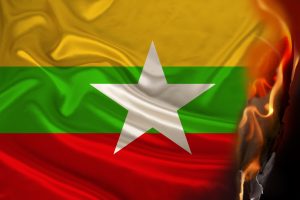The international NGO Save the Children confirmed yesterday that two of its staff were among at least 35 people who were killed in a horrific massacre in eastern Myanmar last week. The organization said the two staff members were caught up in the attack in Kayah State in the east of the country as they were traveling back to their office after conducting humanitarian activities nearby.
“Violence against innocent civilians including aid workers is intolerable, and this senseless attack is a breach of International Humanitarian Law,” Save the Children’s chief executive Inger Ashing said in a statement.
Last week, reports began to circulate on social media regarding a horrific massacre in Kayah State, along with photos showing the bodies of over 30 people in three charred and incinerated vehicles. The victims were reportedly shot and then set on fire by government troops as they fled the fighting that is convulsing increasingly large portions of the country.
“This is not an isolated event,” Ashing added. “The people of Myanmar continue to be targeted with increasing violence and these events demand an immediate response.”
Indeed, the massacre in Mo So village, in Hpruso Township, echoed the atrocity committed by Myanmar troops in Sagaing Region’s Salingyi Township earlier this month. In a reprisal against an attack by a local civilian militia against a military convoy, Myanmar military personnel rounded up 11 villagers, some believed to be children, tied them up, and slaughtered them in the street. The bodies were then similarly set on fire – a measure no doubt intended to terrorize the population into submission.
The Mo So village attack was followed by the usual flurry of outraged but largely impotent responses from the outside world. The U.S. Embassy in Myanmar said it was appalled by the “barbaric attack in Kayah state that killed at least 35 civilians, including women and children.”
The United Nations under-secretary general for humanitarian affairs, Martin Griffiths, said he was similarly “horrified” by credible reports of the killings and demanded – somewhat fruitlessly, it must be said – that the government launch an investigation. “I condemn this grievous incident and all attacks against civilians throughout the country, which are prohibited under international humanitarian law,” he said in a statement, according to The Guardian.
If the massacre of civilians and aid workers showed anything, however, it is that the Myanmar armed forces, or Tatmadaw, are entirely indifferent to the distant dictates of international law. In fact, incidents like this month’s massacres in Sagaing and Kayah are quickly becoming a melancholy and routine occurrence as the military junta, perhaps gripped by a rising sense of panic, employs increasingly harsh methods to secure its hold on power.
In a recent article for Asia Times, the veteran defense analyst Anthony Davis suggested that 2021, which saw a broad popular revolt against Myanmar’s return to military rule, could come to be seen as “a second critical watershed in the nation’s modern history” after only 1948, the year of the country’s independence from British rule. He predicted that the coming year could well decide whether the Tatmadaw or the People’s Defense Forces (PDFs) and ethnic armed groups that oppose it will prevail in their intensifying struggle for the future of the country.
While the longer term outlook for the Tatmadaw is uncertain – the army faces a rising number of challenges, from the difficulty of recruitment to uncertain morale and a dearth of effective personnel – Myanmar’s beleaguered coup regime “has every interest in rapidly exploiting those advantages it still enjoys,” Davis wrote. “Over the dry season months through May 2022, army commanders can be expected to throw the full weight of their forces against PDFs with a focus on Sagaing where the armed revolt is most advanced.”
If anything, the second year of junta rule is shaping up to be even more violent and disruptive than the desolate landmark of 2021.

































